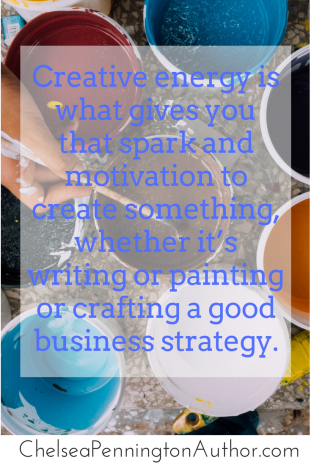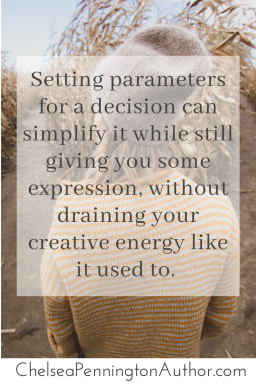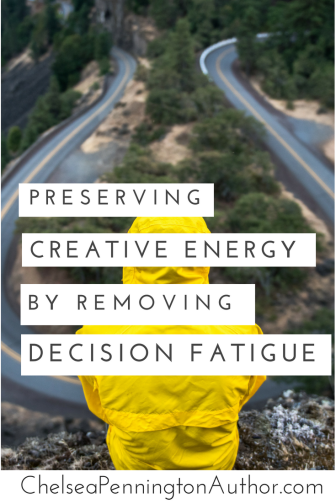Do you ever spend all day running around, whether it’s working, going to school, or just doing errands, then come home in the evening and feel like you’re incapable of writing? You have the time, maybe you’re even sitting at the computer, but the words just won’t come. If this happens over and over, it can even cause us to doubt ourselves as writers. Maybe we’re not cut out for it. Maybe we’re not as good as we thought we were. But there’s a more likely culprit: you’re spending your creative energy elsewhere.

Creative energy is what gives you that spark and motivation to create something, whether it’s writing or painting or crafting a good business strategy. Everyone has it, but everyone also chooses to spend it on different things. A teacher may use it on creating a good lesson plan that engages their students. A doctor may use it to decide on the best course of treatment. People who do creative work for a living (or wish they could) tend to use it on more “typically creative” projects, like writing a novel or designing a graphic logo.
These are all examples of people putting their creative energy to good use, and making it work for them and in their careers. But there are lots of other things that try to use up our creative energy as well. Trying to decide what to make for dinner. Figuring out if you should just buy that thing at the store now, or if you should spend some time researching and looking for a better price. The actual act of researching and looking for a better price! You may notice a pattern—a lot of these drains on creative energy come from having to make a decision. This is sometimes called decision fatigue.
I recently listened to an interview with author and comedian D.L. Hughley, who had a great metaphor for this. Your creative energy is like the water in your house. It can be used for lots of different things—washing dishes, taking a shower, doing the laundry. But if you try to do all these things at the same time, you’re likely going to end up with low water pressure. There’s just not enough to go around. If you use all your creative energy on other things, when it comes time to actually create something, you’ll only get a trickle of creativity, rather than the gushing fountain you were hoping for.
Especially if you’re only able to write in your free time, it’s important to be aware of these drains on creative energy and mitigate them as much as you can. This starts with just being aware of what is draining your energy. Spend a day or even a full week just being mindful of what you’re doing and what is causing you decision angst. Keep a note on your phone and write it down when you notice it. Is it deciding where to get lunch? Responding to that email at work? Whatever it is, write it down.
At the end of your observation period, look at your list. Divide it into two categories: Decisions I can modify, and decisions I can let go. For example, you may get decision angst over what to wear in the morning, but it’s still a choice that exists and you can’t get rid of it completely. But there are other choices you may be able to completely remove from your life, or at least reduce their frequency, such as when and if you should exercise. (No, the solution isn’t to stop exercising completely—just keep reading!)
Now, take a look at your first category, decisions you can modify. Go through the items and decide what you can and are willing to do. This second part is important. For example, if you get decision angst over what to wear in the morning, you could buy ten of the same outfit and wear the exact same thing every day. Some people do this and it works fine for them. But this might drive you nuts, and you’d give up on it after a week.

So maybe instead, set a time limit—you have ten minutes in the morning (or, even better, do it the night before!) to decide what to wear, and when time’s up, that’s what you go with. The same thing can happen with deciding what to eat—maybe you don’t want to eat the same meal every single day, but you can decide on a schedule: Friday is pizza night, maybe on Monday you always make pasta, etc. Setting parameters for a decision can simplify it while still giving you some expression, without draining your creative energy like it used to.
But you’re not done yet. There’s the second category of decisions you can let go. I mentioned exercise as an example. Yes, you could decide to just stop exercising, but I am not recommending that! Instead, make the choice once and let it go. Just like it’s a foregone conclusion that you’ll brush your teeth every morning and night (I hope…) treat exercise like that, choosing the days and times you want to exercise and then letting it go. Then, when it’s Wednesday afternoon, you’ve already decided that you’re going to the gym and you don’t have to agonize over it. Making a decision once and then acting like you have no other option takes practice, but it does get easier, and it’s worth it.
There are also probably some decisions that you can let go of, period. For instance, this blogger talks about how their membership to Costco caused her decision angst because she could never decide when was the best time to make the trip and if they were wasting money on the membership, and so they just got rid of the membership, removing the decision completely.
Once you’ve modified or let go of decisions in your life, not only will you be able to harness your creative energy for actually creating, you’ll likely find you have more time and less stress. It’s amazing how a small change can revolutionize your life, and I challenge you to see how decreasing decision fatigue can change yours.

Have you experienced decision fatigue? What do you do to combat it? How do you protect your creative energy? Let me know in the comments!
You may also like . . .
Cover photo by Justin Luebke




One thought on “How to preserve creative energy by removing decision fatigue”